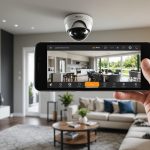Understanding Home Automation
Home automation technology is transforming traditional living spaces into smart homes. By using smart devices such as thermostats, lighting systems, and security cameras, homeowners can automate and remotely control various home functions, enhancing convenience and efficiency. The benefits include energy savings, improved security, and increased accessibility, making daily life more comfortable and efficient.
Among the types of devices commonly used in home automation are smart light bulbs, thermostats, and home assistants. These devices often communicate over standard protocols like Wi-Fi, Zigbee, or Z-Wave, allowing them to work harmoniously within a network. By intelligently responding to user behaviors and environmental conditions, they contribute significantly to modern home management.
Also to see : Mastering Smart Home Surveillance: Step-by-Step Smartphone Installation Guide
Perhaps most importantly, smartphone integration plays a pivotal role in managing smart homes. Through dedicated apps, users can monitor and control their home devices from anywhere in the world. Whether adjusting the thermostat on the way home or checking the security cameras while on vacation, smartphone integration ensures that the power of home automation is at your fingertips, providing peace of mind and enhanced control over your living environment.
Setting Up Your Smart Home
Setting up a smart home is an exciting journey towards enhanced living. Choosing the right smart home setup is crucial for seamless operation. Start by selecting smart devices that meet your needs and budget. Remember, identifying devices that align with your lifestyle can greatly improve convenience and functionality.
Also read : Transform Your Phone into a Smart Home Command Center: Expert Tips and Strategies
Next, a central hub is vital for managing these devices. Whether opting for a dedicated hub like Samsung SmartThings or integrating through a virtual assistant like Amazon Alexa, centralising control simplifies device management. This setup ensures all devices communicate effectively with one another.
Connecting your devices through smartphone applications is the next step. Most smart devices come with dedicated apps that allow you to connect, control, and monitor them remotely. These apps often provide valuable insights into your home’s energy usage and can be customised to suit your preferences.
Before fully installing your devices, ensure compatibility with your central hub and determine the best locations for optimal connectivity. Once connected, test each device through your smartphone to ensure they respond correctly. Following these steps will foster a comprehensive and efficient smart home setup, paving the way for intelligent living.
Optimizing Smart Home Performance
Optimizing your smart home performance ensures smoother operation and enhanced efficiency. Start by ensuring your devices have strong, reliable connectivity. Wi-Fi routers with good coverage can significantly improve device performance. If you experience connectivity issues, consider using range extenders to eliminate dead zones.
Regular software updates are crucial for maintaining device functionality and security. Most smart devices come with features that allow automatic updates, ensuring your system has the latest improvements. Also, routinely check for firmware updates through your device applications.
Introducing automation routines is a clever way to boost efficiency. Devices can be programmed to perform tasks based on schedules or triggers, such as turning lights off when leaving home or adjusting thermostats based on weather. These routines save time and energy while ensuring a comfortable environment.
Device maintenance is another vital aspect. Regular cleaning and inspections prevent dust and debris from affecting performance, particularly in devices like cameras and sensors. Furthermore, periodically reviewing device settings ensures optimal operation and helps identify areas for performance enhancement.
By following these tips, you can effectively enhance your smart home’s reliability and functionality, ensuring a seamless and efficient living experience.
Troubleshooting Common Issues
In the dynamic world of smart home automation, encountering hitches isn’t uncommon. Many find themselves facing connectivity issues. A typical problem is devices losing contact with the central hub. To resolve this, ensure that your Wi-Fi router covers all necessary areas, or consider adding extenders to boost signals in dead zones.
Another frequent problem is device-specific errors, which may manifest as unresponsive gadgets. A common fix involves restarting the device or re-assessing its connection path. Sometimes, misunderstood commands cause issues. Subtle aspects like placement or interference could be the root cause.
Beyond common errors, turning to support resources is advantageous. Manufacturers often have comprehensive online FAQs or user forums to aid consumers. Professional consults, available online or in-store, can provide tailored support.
In the broader scheme, understanding these hiccups and how to address them ensures a more cohesive experience. Confidence in troubleshooting enhances the reliability of your smart home, ensuring it remains a hub of convenience and control.
Comparing Popular Home Automation Systems
Navigating the wide variety of home automation systems available can be overwhelming. Prominent options include Samsung SmartThings, Google Home, and Amazon Alexa, each offering distinct features. Samsung SmartThings excels in device compatibility, supporting a myriad of third-party devices via Zigbee and Z-Wave protocols. Google Home is known for its seamless integration with Google’s ecosystem, providing intuitive voice control through Google Assistant. Amazon Alexa boasts a comprehensive range of compatible devices, coupled with user-friendly routines that enhance customisation.
When choosing a system, consider the features and functionalities that best suit your lifestyle. Voice activation, ease of integration, and device support are crucial aspects. Assess the cost and scalability; systems like SmartThings may involve higher initial costs but offer expansive growth, whereas Google Home and Amazon Alexa typically have more affordable entry points.
Consider the longevity and development of these platforms. Companies actively innovate, ensuring regular updates introduce new capabilities and improve security. Aligning a system with your current and future needs enhances the smart home experience, allowing for adaptability as technology evolves.
Best Practices for Smart Home Security
Securing your smart home requires adopting essential measures to protect against potential threats. A crucial first step is using strong passwords. Ensure that each device has a unique, complex password to reduce the risk of breaches. Regularly updating passwords can help in maintaining security integrity.
In addition to passwords, keeping your devices and applications up-to-date is vital. Software updates often include patches for vulnerabilities, therefore enabling automatic updates is recommended to bolster security without needing constant manual intervention.
It’s equally important to invest in recommended security devices for enhanced protection. Consider the following:
- Smart door locks offer better control over access to your home.
- Surveillance cameras provide real-time monitoring and alerts.
- Home security systems include sensors and alarms that notify you of unusual activities.
When managing these devices, ensure your home Wi-Fi network is secure. Use encryption like WPA3 and disable unnecessary features like WPS to prevent unauthorized access. By implementing these best practices, you enhance the safety of your smart home, fostering a secure environment where your smart devices can operate optimally and without undue risk.
Integrating Smart Home Devices
To achieve a seamlessly functioning smart home, proper smart device integration is crucial. This involves ensuring that all devices within your home can communicate efficiently. Most devices adhere to communication standards like Wi-Fi, Zigbee, or Z-Wave. These standards facilitate compatibility, enabling various devices, like smart thermostats and lighting, to work together without conflicts.
Creating a cohesive system also involves carefully selecting devices known for compatibility. For instance, opting for a well-supported platform, such as Amazon Alexa or Google Home, ensures a smoother integration process. These platforms often provide a broad ecosystem, allowing diverse devices to connect seamlessly. Integration becomes even more effective when the platforms offer open APIs, enabling new devices to be added as technology evolves.
Voice control is a significant advantage of smart device integration. Systems equipped with Alexa or Google Assistant allow users to control devices verbally, simplifying interactions. Moreover, integrating automation routines can further enhance efficiency. By setting triggers and schedules, homeowners can automate daily tasks, such as adjusting lights or setting the thermostat, based on specific conditions. Such integration ensures not only convenience but also optimises energy use.
Recommended Apps for Home Automation
Navigating the world of home automation apps can greatly enhance your smart home experience. With a plethora of options available, selecting the top smartphone applications tailored to your needs can maximise convenience. Home automation apps like Google Home, Amazon Alexa, and Apple HomeKit provide robust platforms for device management, each offering unique features. Google Home offers seamless integration with Google’s ecosystem, allowing voice control and routine automation. Amazon Alexa excels in customisation with its wide compatibility range. Apple HomeKit boasts a user-friendly interface, ensuring intuitive device management across Apple devices.
When choosing the best app, consider features such as device compatibility, ease of use, and integration capabilities. Many apps offer automation routines, enabling devices to perform tasks based on time or triggers, enhancing efficiency. Additionally, look for apps that provide energy usage insights, helping you monitor consumption and optimise savings.
Ultimately, selecting the right home automation apps involves aligning app functionalities with your lifestyle needs. As technology evolves, these apps continue to enhance connectivity and control, creating innovative solutions that reflect your personalised smart home environment.
Future Trends in Home Automation
The landscape of smart home technology is rapidly evolving, with exciting trends on the horizon. One significant trend is the integration of AI and machine learning into home automation. These technologies enable devices to learn user preferences, enhancing personalisation and efficiency. For example, an AI-driven home assistant can adjust lighting or climate automatically based on past behaviours, providing a more customized living experience.
As the world moves towards sustainability, the impact of renewable energy on smart homes is becoming more pronounced. Home automation systems are increasingly integrating with solar panels and other renewable sources, allowing for more eco-friendly energy consumption. This not only reduces the carbon footprint but also offers potential cost savings on energy bills.
Moreover, smart homes are expected to further refine connectivity standards like Wi-Fi 6 and new protocols promising faster and more reliable connections. These developments will support the adoption of next-generation devices that require high-speed internet and seamless integration.
These trends signal a promising future for smart homes, where technology continues to cater to individual needs while promoting environmental responsibility. With innovations like AI, renewable energy, and improved connectivity, the future of home automation looks both exciting and sustainable.











